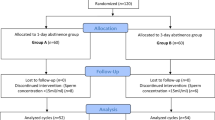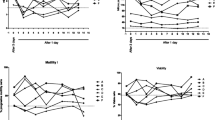Abstract
Objective
The aim of this study was to evaluate recent publications and determine the impact of ejaculatory abstinence on semen analysis parameters as well as fertility outcomes.
Methods
This was a systematic review of 28 recent publications. The focus of this study was the impact of abstinence on semen parameters and fertility outcomes in papers published since the year 2000. The specific parameters evaluated were volume, sperm count, motility, morphology, pH, DNA fragmentation rate, viability, and pregnancy or fertilization rates following assisted reproduction.
Results
Twenty-eight recent publications met inclusion criteria. Analysis of publications showed that longer abstinence is associated with increases in semen volume and sperm count. Studies evaluating the effect of abstinence on motility, morphology, and DNA fragmentation rates are contradictory and inconclusive, although a trend appears to exist toward improvements in semen parameters with shorter abstinence. Semen pH was unaffected by abstinence. The majority of publications found no difference in rates of viability with varying abstinence times, although total number of viable sperm increases with increasing abstinence. Some studies evaluating the impact of ejaculatory abstinence on intrauterine insemination (IUI), intracytoplasmic sperm injection (ICSI), and in vitro fertilization (IVF) demonstrated an association between short abstinence and improved outcomes.
Conclusions
The impact of abstinence on sperm quality is complex. While certain semen parameters improve with longer abstinence, others appear to improve with shorter abstinence. No clear recommendations can be made regarding ideal abstinence due to the conflicting nature of current evidence. Going forward, more research is needed to evaluate the impact of abstinence on pregnancy and fertilization rates.

Similar content being viewed by others
References
World Health Organization, Department of Reproductive Health and Research. WHO laboratory manual for the examination and processing of human semen. 5th ed. Switzerland: WHO Press; 2010. p. 10–11.
De Jonge C. Influence of the abstinence period on human sperm quality. Fertil Steril. 2004;82(1):57–65.
Levitas E. Relationship between the duration of sexual abstinence and semen quality: analysis of 9,489 semen samples. Fertil Steril. 2005;83(6):1680–6.
Agarwal A. Abstinence time and its impact on basic and advanced semen parameters. Urology. 2016;94:102–10. 1527-9995. 27196032
Mayorga-Torres B. Influence of ejaculation frequency on seminal parameters. Reprod Biol Endocrinol. 2015;13:47.
Gonzalo A. Influence of ejaculatory abstinence on the characteristics of spermiogram. Systematic review. Rev Chil Obstet Ginecol. 2013;78(4):290–2. 0048766X
Sobreiro B. Semen analysis in fertile patients undergoing vasectomy: reference values and variations according to age, length of sexual abstinence, seasonality, smoking habits and caffeine intake. Sao Paulo Med J. 2005;123(4):161–6. 1516-3180. 16389413
DeJonge C. Influence of the abstinence period on human sperm quality. Fertil Steril. 2004;82(1):57–65. 0015-0282. 15236990
Welliver C. Analysis of semen parameters during 2 weeks of daily ejaculation: a first in humans study. Transl Androl Urol. 2016;5(5):749–55. 27785432
Makkar G. A comparative study of raw and prepared semen samples from two consecutive days. J Reprod Med. 2001;46(6):565–72. 0024-7758. 11441681
Marshburn P. Influence of ejaculatory abstinence on seminal total antioxidant capacity and sperm membrane lipid peroxidation. Medecine Therapeutique Medecine de la Reproduction, Gynecologie et Endocrinologie. 2014;16(4):289–90. 12959359
Wang L. Influence of the abstinence period on human semen parameters. Chin J Androl. 2007;21(8):21–3. 10080848
Lehavi O. Twenty-four hours abstinence and the quality of sperm parameters. Andrologia. 2014;46(6):692–7. 1439-0272. 23879893
Marshburn P. A short period of ejaculatory abstinence before intrauterine insemination is associated with higher pregnancy rates. Fertil Steril. 2010;93(1):286–8. 1556-5653. 19732887
Sanchez-Martin P. Increased pregnancy after reduced male abstinence. Syst Biol Reprod Med. 2013;59(5):256–60. 1939-6376. 23651301
Sunanda P. Effect of age and abstinence on semen quality: a retrospective study in a teaching hospital. Asian Pac J Reprod. 2014;3(2):134–41. 23050500
Sugiyam R. Improvement of sperm motility by short-interval sequential ejaculation in oligoasthenozoospermic patients. Arch Med Sci. 2008;4(4):438–42. 17341922
Li W. Influence of abstinence time on young man semen quality. Fudan Univ J Med Sci. 2003;30(4):391–3. 16728467
Zhang X. The best abstinence period for donoring semen. Chin J Androl. 2009;23(1):39–41. 47. 10080848
Pasqualotto F. Influence of abstinence period on seminal characteristics in infertile men. Rev Bras Ginecol Obstet. 2006;28(1):44–9. 01007203
Rivaroli M. Comparison between length of sexual abstinence and semen parameters in patients of an assisted reproduction center and a hospital from Porto Alegre—RS. J Bras Reprod Assist. 2009;13(2):28–32. 15175693
Raziel A. Influence of a short or long abstinence period on semen parameters in the ejaculate of patients with nonobstructive azoospermia. Fertil Steril. 2001;76(3):485–90. 0015-0282. 11532469
Mayorga-Torres J. Can a short term of repeated ejaculations affect seminal parameters? J Reprod Infertility. 2016;17(3):177–83. 2228-5482. 27478772
Jurema M. Effect of ejaculatory abstinence period on the pregnancy rate after intrauterine insemination. Fertil Steril. 2005;84(3):678–81. 1556-5653. 16169402
Carlsen E. Effects of ejaculatory frequency and season on variations in semen quality. Fertil Steril. 2004;82(2):358–66. 0015-0282. 15302284
AlAwlaqi A, Hammadeh ME. Sexual abstinence and sperm quality. International Journal of Women’s Health and Reproductive Sciences. 2017;5(1):11–17.
Bahadur G. Semen characteristics in consecutive ejaculates with short abstinence in subfertile males. Reprod BioMed Online. 2016;32(3):323–8. 1472-6491. 26776821
Elzanaty S. Duration of sexual abstinence: epididymal and accessory sex gland secretions and their relationship to sperm motility. Hum Reprod. 2005;20(1):221–5. 0268-1161. 15550495
Zhou J. The semen pH affects sperm motility and capacitation. PLoS One. 2015;10(7):1–15. e0132974.
Pons I. One abstinence day decreases sperm DNA fragmentation in 90% of selected patients. J Assist Reprod Genet. 2013;30(9):1211–8. 1573-7330. 23996278
Gosalvez J. Shorter abstinence decreases sperm deoxyribonucleic acid fragmentation in ejaculate. Fertil Steril. 2011;96(5):1083–6. 1556-5653. 21924714
Wang C. Limitations of semen analysis as a test of male fertility and anticipated needs from newer tests. Fertil Steril. 2014;102(6):1502–7.
Author information
Authors and Affiliations
Corresponding author
Rights and permissions
About this article
Cite this article
Hanson, B.M., Aston, K.I., Jenkins, T.G. et al. The impact of ejaculatory abstinence on semen analysis parameters: a systematic review. J Assist Reprod Genet 35, 213–220 (2018). https://doi.org/10.1007/s10815-017-1086-0
Received:
Accepted:
Published:
Issue Date:
DOI: https://doi.org/10.1007/s10815-017-1086-0




